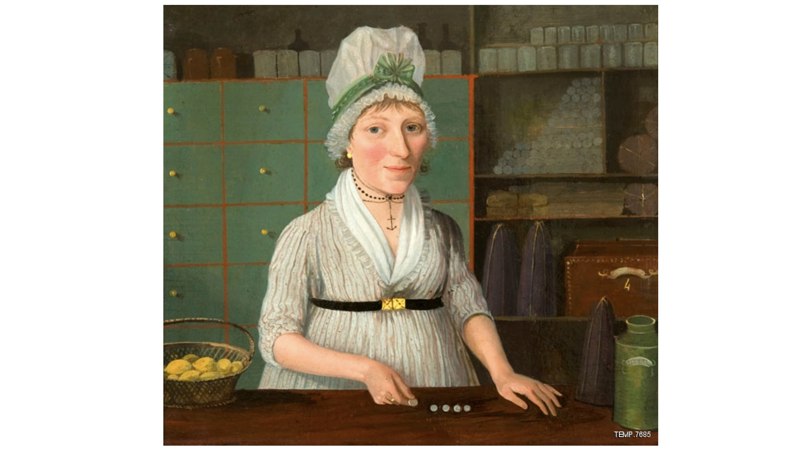Selling West Indian Sugar and Rum in Glasgow

The Woman Shopkeeper, artist unknown, c.1790-1800
TEMP.7685
Images © CSG CIC Glasgow Museums Collection
15th July 2020
The artist and the sitter’s identities for this unique portrait of a woman working in a grocery shop c. 1790 to 1825 in Glasgow Museum’s collections are as yet unknown and remain to be discovered. However, not all is lost because this portrait has attracted more attention in recent years, when she interpreted it in terms of a study of Georgian women at work.
 Although this is a unique portrait, this woman was not working alone. A cursory glance through the street directories for Glasgow from 1783 (Tait) and 1787 (Jones), and Edinburgh for 1784 and 1785 (Williamson) record women working in trades and from shops which they probably owned or rented as part of a tenement with the commercial premises on the ground floor and the residence above it. The trades are commonly in textile and foods, and in this case the painting probably presents a grocery rather than a spirit store, tobacconist or vintners (off-licence).
Although this is a unique portrait, this woman was not working alone. A cursory glance through the street directories for Glasgow from 1783 (Tait) and 1787 (Jones), and Edinburgh for 1784 and 1785 (Williamson) record women working in trades and from shops which they probably owned or rented as part of a tenement with the commercial premises on the ground floor and the residence above it. The trades are commonly in textile and foods, and in this case the painting probably presents a grocery rather than a spirit store, tobacconist or vintners (off-licence).
Examples of women working as grocers in Glasgow’s city centre in 1783 (Gallowgate, Argyle Street, Trongate and High Street) included Mrs Angus (High Street), Miss Christie (Trongate), Mrs Lowrie (Gallowgate), Mrs Matthie (High Street), Mrs Miller (Gallowgate) and Mrs Neilson (King Street).
As well as being called grocers they were also often called spirit dealers, and this painting may allude to this for although the green neat drawers may have carefully packed teas, coffees and chocolates stored, and the candles are kept in a cupboard, the basket of lemons and profusion of sugar cones on the main shop counter are key ingredients to a mainstay of Glaswegian parties and entertainments of the period – rum punches. Should she also be selling Caribbean rum too, then she is being both a grocer and a spirit dealer and joining in the group of professional business women in Glasgow at this time.
The celebration of Glasgow’s investment in the sugar industry both within the city’s own sugar houses, and its links to Caribbean sugar plantations, was also a celebration of chattel slavery. The commonality of the grocery and spirit shops, the easy availability of the sugar and rum products, and the extent to which people consumed sugar, rum and tobacco taken were legacies of the industrial scale of production of such products and by default Glasgow’s legacy and indebtedness to slavery and empire.
Dr Anthony Lewis,
Curator of Scottish History
